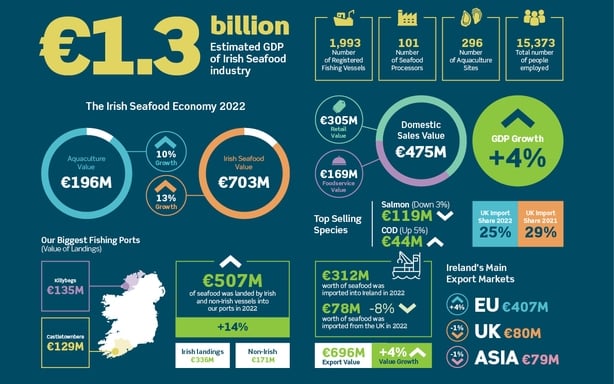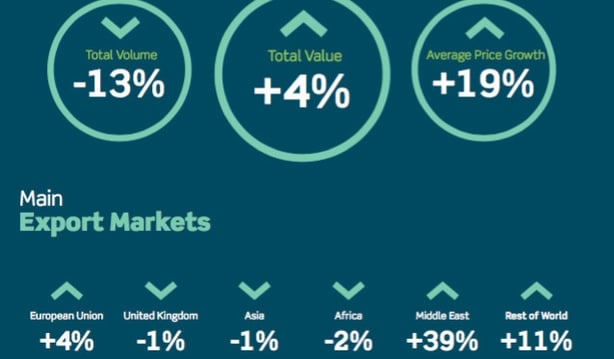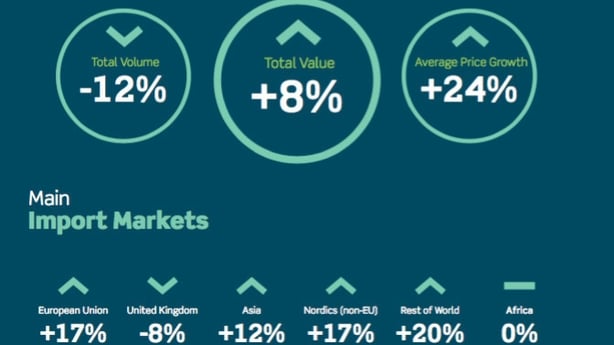Ireland's seafood economy grew by 4% last year to a value of €1.3 billion, according to new figures from Bord Iascaigh Mhara.
The growth was mainly driven by an increase in the consumption of seafood here, which was up 13.5% on the previous year to €475m.
This was partly due to strong demand from the hospitality sector, which grew by 70% from 2021 to €169m, as the sector continued to recover following the pandemic.
However, today's report states that strong growth in the foodservice sector was offset by a 4% decline in the value of sales in the retail sector.

Inflation
Inflation hit the sector significantly last year, with the price of salmon increasing 9% and cod up 7%.
These price increases led to demand falling by 11% and 3% respectively.
"We are producing premium products here in Ireland, so there are very strong export markets," said Caroline Bocquel, CEO of Bord Iascaigh Mhara.
Speaking on Morning Ireland, she said Irish seafood is commanding strong prices on international markets, and domestically.
Haddock and whiting were the only species that saw prices decreasing, down 2% for both.
As a result, sales volumes increased by 16% and 13% respectively.
Prices for wild caught fish saw the biggest increase, according to the latest figures.
Dublin Bay Prawns surpassed mackerel as the most valuable wild caught species for the industry, having more than doubled in price in 2022.
We need your consent to load this rte-player contentWe use rte-player to manage extra content that can set cookies on your device and collect data about your activity. Please review their details and accept them to load the content.Manage Preferences
Trade
Overall, the report shows that trade volumes were down last year.
The volume of exports fell by 13% to 293,000 tonnes due mainly to the lower quotas of mackerel and blue whiting as a result of Brexit.
However, the value of exports increased by 4% to €696m.
Exports to the UK decreased for the third year in a row, with the report citing "difficulties in trading with the UK created by Brexit".
Exports to the EU continued to grow to €407 million up from €393 million in 2021.
"Exports to the EU are up 4% and that is largely driven by a new market in Italy," said Ms Bocquel.
"We're also seeing the gains we made last year when we doubled the exports to the Asian market, and a 39% increase in exports to the Middle East - so we have very strong trade with those new markets," she added.

Overall investment in the sector decreased marginally during 2022 to €443m, reflecting continued uncertainty in the sector.
Imports of seafood showed a similar pattern, with an overall decrease in volume of 12%, a decline of around 20,000 tonnes.
The cost of imported seafood increased by 24%, leading to an increase in value to €312m, compared to €287m in 2021.
Volumes of salmon, prawns and tuna imports, which are traditionally major import species all declined but value increased by an average of 9%.
The data shows that the imports of lower value species such as tilapia, pangasius and seabass all increased last year, as consumers looked for ways to cut back on spending.
Imports from all countries declined last year, as prices jumped across the world.
Ms Bocquel said these figures show that Ireland is reducing its reliance on seafood imports.
"Processors are choosing to use more sustainably caught Irish seafood, rather than relying on imports - this is good and we would like to see that trend continue," she added.

The decline in imports from the UK seen since 2020 continued, with both volume and value of UK imports declining by 37% and 8% respectively.
"The trading difficulties presented by Brexit are the main contributor to this decline, which now seems systemic," the report states.
Since 2019, the volume of seafood imports from the UK has halved and the value has declined by two thirds.
Challenges for the sector
The report states that the continued conflict in Ukraine, which has caused energy prices to skyrocket, remains a "huge threat" to the viability of the seafood industry both here and globally.
While the price of marine diesel stabilised somewhat towards the end of 2022 and into the early months of 2023, the outlook for energy costs is volatile.
"The sector has a high level of dependence on fossil fuels and given the current geopolitical uncertainty, this leaves the seafood sector exposed to volatility in the energy market," the report states.
"Developing ways to reduce this dependence on marine diesel as well as cutting carbon emissions in line with achieving Net Zero by 2050 will require a collective effort from the industry backed with financial and technical support from Government to withstand this challenge and ensure economic viability in the years to come."
Employment
Employment across the seafood industry fell last year.
A total of 15,373 people were employed directly and indirectly within the sector, a decrease in overall employment of 8%.
This comprised 8,218 employed directly in fisheries, aquaculture and processing, and a further 7,155 in downstream employment in ancillary and support sectors.
Speaking on Morning Ireland, Ms Bocquel acknowledged the employment challenges across all sectors in Ireland at the moment.
She said they would be confident of addressing that decline this year.
"In our colleges we have a very strong throughput of the next generation of skippers there," she said.
She said they are also using the Brexit Adjustment Reserve as a tool to try to fund more innovation in companies.
"We are seeing a large uptake with our processing companies relying on that fund to fund new innovations so they can automate production lines and rely on artificial intelligence to do much of the work.
Today's report shows that employment remains high in coastal regions, with the seafood industry accounting for 14% of coastal employment in Donegal, 7% in the north-west region, 6% on the south-western and southern coasts and 6% in Galway-Clare.
The seafood industry as a whole, accounted for 6% of total coastal employment.
Killybegs in Co Donegal was the State's largest fishing port in 2022 by value, with landings worth €135m, closely followed by Castletownbere in Co Cork, with €129m worth of catch landed.







